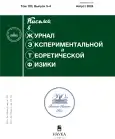Synthesis and properties of 12442-family superconductor
- Authors: Zhuvagin I.V1, Vlasenko V.A1, Usoltsev A.S.1, Gippius A.A1, Pervakov K.S.1, Prishchepa A.R1, Prudkoglyad V.A1, Gavrilkin S.Y.1, Denishchenko A.D1, Sadakov A.V1
-
Affiliations:
- Lebedev Physical Institute, Russian Academy of Sciences
- Issue: Vol 120, No 3-4 (2024)
- Pages: 286-287
- Section: Articles
- URL: https://journals.rcsi.science/0370-274X/article/view/262264
- DOI: https://doi.org/10.31857/S0370274X24080214
- EDN: https://elibrary.ru/AWITRA
- ID: 262264
Cite item
Full Text
Abstract
We report a synthesis of two members of recently discovered high-temperature superconductors of 12442 family, with formula MCa2Fe4As4F2 (M=Rb,K) and transition temperatures of 32.7 and 34.6K, respectively. Quality of the samples was assessed using X-ray powder diffraction, superconducting transitions were identified through transport and magnetic experiments. The temperature dependence of the upper critical field and vortex activation energy was investigated under magnetic fields up to 19T. Two distinct thermally activated flux flow regimes were observed in both systems. Field dependences of activation energy U0(H) indicate a change in the properties of vortex matter in these regimes and distinctly different dissipation mechanisms, reminiscent of cuprate HTSC.
About the authors
I. V Zhuvagin
Lebedev Physical Institute, Russian Academy of Sciences
Email: andrey.sadakov@gmail.com
Moscow, Russia
V. A Vlasenko
Lebedev Physical Institute, Russian Academy of Sciences
Email: andrey.sadakov@gmail.com
Moscow, Russia
A. S. Usoltsev
Lebedev Physical Institute, Russian Academy of Sciences
Email: andrey.sadakov@gmail.com
Moscow, Russia
A. A Gippius
Lebedev Physical Institute, Russian Academy of Sciences
Email: andrey.sadakov@gmail.com
Moscow, Russia
K. S. Pervakov
Lebedev Physical Institute, Russian Academy of Sciences
Email: andrey.sadakov@gmail.com
Moscow, Russia
A. R Prishchepa
Lebedev Physical Institute, Russian Academy of Sciences
Email: andrey.sadakov@gmail.com
Moscow, Russia
V. A Prudkoglyad
Lebedev Physical Institute, Russian Academy of Sciences
Email: andrey.sadakov@gmail.com
Moscow, Russia
S. Yu Gavrilkin
Lebedev Physical Institute, Russian Academy of Sciences
Email: andrey.sadakov@gmail.com
Moscow, Russia
A. D Denishchenko
Lebedev Physical Institute, Russian Academy of Sciences
Author for correspondence.
Email: andrey.sadakov@gmail.com
Moscow, Russia
A. V Sadakov
Lebedev Physical Institute, Russian Academy of Sciences
Email: andrey.sadakov@gmail.com
Moscow, Russia
References
- Z.C. Wang, C.Y. He, S.Q. Wu, Z.T. Tang, Y. Liu, A. Ablimit, C.-M. Feng, and G.H. Cao, J. Am. Chem. Soc. 138(25), 7856 (2016); https://doi.org/10.1021/jacs.6b04538.
- Z. Wang, C. He, Z. Tang, S. Wu, and G. Cao, Sci. China Mater. 60, 83 (2017); https://doi.org/10.1007/s40843-016-5150-x.
- X. Yi, M. Li, X. Xing, Y. Meng, C. Zhao, and Z. Shi, New J. Phys. 22(7), 073007 (2020); https://doi.org/10.1088/1367-2630/ab9427.
- N.R. Werthamer, E. Helfand, and P.C. Hohemberg, Phys. Rev. 147, 295 (1966); https://doi.org/10.1103/PhysRev.147.295.
- G. Blatter, M.V. Feigel’man, V.B. Geshkenbein, A. I. Larkin, and V.M. Vinokur, Rev. Mod. Phys. 66, 1125 (1994); https://doi.org/10.1103/RevModPhys.66.1125.
- Z. Liu, C. Wang, C. Xu, M. Hao, H.-M. Cheng, W. Ren, and N. Kang, 2D Mater. 6, 021005 (2019); https://doi.org/10.1088/2053-1583/ab0d2e.
- C. Zhang, T. Hu, T. Wang, Y. Wu, A. Yu, J. Chu, H. Zhang, X. Zhang, H. Xiao, W. Peng, Z. Di, S. Qiao, and G. Mu, 2D Mater. 8, 025024 (2021); https://doi.org/10.1088/2053-1583/abdaba.
- H. Zhang, Y. Fang, T. Wang, Y. Liu, J. Chu, Zh. Li, D. Jiang, G. Mu, Z. Di, and F. Huang, Phys. Rev. B 103, L180503 (2021); https://doi.org/10.1103/PhysRevB.103.L180503.
Supplementary files










